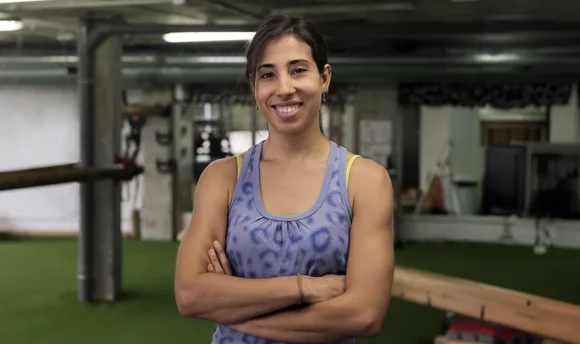Working Out 7 Days a Week: Risks, Benefits, and Schedule
Working out 7 days a week isn’t for everyone, but those who can buckle down and make daily exercise a habit won’t regret it.

Most of us are well aware of the benefits of working out. From feeling more confident in our bodies to improved mental clarity, working out can improve almost every aspect of our lives.
But as with all good things in life, is there a point at which the tables take a turn for the worst?
Keep reading to find out if working out 7 days a week can help you reach your fitness goals faster or if it could end up doing more harm than good.
Is It Okay/Safe to Be Working Out Every Day?
Everyone’s bodies require at least a little bit of rest. That being said, there is no reason you can’t take on a schedule of working out 7 days a week.
Pencil in enough active recovery days to ensure you don’t overwork your body and can enjoy all the benefits of daily exercise without running the risk of overdoing it.
How often should I work out?
The number of workouts you should partake in each week will vary depending on your level of fitness as well as your particular fitness goals.
The American College of Sports Medicine recommends moderate-intensity aerobic activity for 30 minutes five days per week or high-intensity aerobic activity for 20 minutes at least three days per week to maintain optimal health.
In addition to regular workouts, it’s important to follow a healthy eating plan. Getting enough carbohydrates, protein, and nutritious fruits and vegetables is the best way to set your body up for optimal performance.
Not to mention that a combination of good food and plenty of exercises gives you the best chance of meeting your fitness goals, regardless of whether you’re trying to shed pounds or generally feel better in your body.
What Are the Benefits of Working Out 7 Days a Week?
Most of us know the benefits we can expect when working out. Things like wanting to lose
weight or achieve an overall more toned look are often what drive people to start working out, but the increase in overall vitality is usually what keeps people coming back.
The following section will give you a better idea of exactly what you can expect from working out 7 days a week.
#1 Creating a sense of routine
Often, the people who decide to start working out 7 days a week do so to create strong habits and a routine that helps them consistently work toward their health and wellness-related goals.
Sticking to a daily routine can help people feel more in control of their lives, and a lot of people depend on their daily habits to give them a sense of structure which, combined with the stress-reducing effects of exercise, can help them live a more worry-free life.
#2 Boosting your mood
Regular exercise is one of the best ways for you to stave off feelings of isolation, loneliness, and depression.
Not only does it aid in the release of feel-good hormones like serotonin, but it can also boost the creation of endorphins, which are neurotransmitters released to relieve discomfort when our bodies are experiencing pain or stress.
Working out 7 days a week also gives you an excuse to get out of the house all seven days of the week. Getting outside and spending time with others is crucial to us having the opportunity to form close social bonds and experience all the benefits of having a strong community.
#3 Improving your brain function
Decreasing the amount of stress and anxiety we feel on a day-to-day basis is sure to clear the way for better and more inspired thinking, and the fact that exercise actually improves our memory and brain function is a great added bonus.
Exercise boosts the creation of new brain cells, increases the amount of blood making its way to our brain, and also keeps all areas of our mind more active as its motor systems plan and coordinate more complex movements.
#4 Keeping your heart healthy
Cardiovascular disease is the leading cause of death and accounts for nearly 18 million deaths per year globally.
Most of these cardiovascular complications result from heart attacks and strokes. Both of these illnesses occur when fatty deposits are left to build up on the inner walls of the arteries, where they can either limit blood flow to the heart or become dislodged and disrupt blood flow to the brain.
Increased blood flow during exercise helps to keep these fat deposits from forming and can even help stabilize or reduce any existing buildup.
#5 Strengthening bones and muscles
One of the biggest benefits of regular exercise is that – on a muscular level, anyway – it can reduce the effects of aging.
According to a study, losing muscle mass as you age has less to do with the effects aging has on our bodies and more with living a sedentary life.
Get in the habit of following a regular workout program. Even one that focuses on lower-intensity workouts instead of high-intensity workouts or lifting weights can help keep your bones and muscles strong for years to come.
#6 Burning more fat
Wanting to lose weight is a common goal of almost anyone who starts working out. And while lifting weights and weight training might not help you lose weight since muscle weighs more than fat, doing a combination of weight training and running can help you lose even stubborn fat.
As you gain muscle throughout all the different muscle groups in the body, you will also begin burning more calories, even when you’re at rest. This will make all your weight loss goals even more accessible.
Dangers of Working Out Every Day
Although there are endless benefits of working out every day, there are also some risks associated with taking on the intense exercise regime of working out seven days a week.
By being aware of the potential hazards, you give yourself the best opportunity to mitigate them.
#1 Not enough time for recovery
As you exercise, you create microscopic tears in your muscle fibers. And while this might sound like a bad thing, the truth is these small tears are essential to your muscles building up bigger and stronger than they were previously – as long as they have enough time to recover.
If you continue to work the same muscle groups every day, eventually, they will be so fatigued that you will be running the risk of a more serious injury.
#2 Easy to become bored
Monotony is a risk for anyone who chooses to do something every day. Whether it’s doing the same weight training workout every day or always eating the same meal, chances are, eventually, you will crave some novelty.
Sticking to the same workout style or type of exercise every day can leave you at a higher chance of getting bored and possibly quitting your new workout routine altogether, but it can be offset by doing things like running interval training, which includes a variety of workouts.
#3 Can cause unnecessary stress
It’s true that working out can reduce stress, but this only happens when our bodies are already acclimated to regular high-intensity workouts.
When we exercise, our bodies respond by releasing the stress hormones adrenaline and cortisol. When we return to rest, this return to homeostasis is actually what produces a calming effect on the body.
But working out too hard, too often, will actually inhibit our body’s ability to return to a state of calm and can have a deteriorating effect on our bodies and minds.
7-Day Gym/Strength Workout Schedule
Monday
Beginner
Weightless upper-body workout:
- Push-ups – 45 seconds / 15 seconds rest
- Pike push-ups – 45 seconds / 15 seconds rest
- Snow angels – 45 seconds / 15 seconds rest
- Plank-ups – 45 seconds / 15 seconds rest
- Push-up (right side) – 30 seconds / Push-up (left side) 30 seconds / 15 seconds rest
- Arm circles – 30 seconds / 15 seconds rest
- Plank – 30 seconds / 15 seconds rest
- Ankle taps – 60 seconds / 15 seconds rest
- Push-ups – 45 seconds / 15 seconds rest
- Roof raise – 45 seconds / 15 seconds rest
- Wide push-up – 30 seconds / 15 seconds rest
- Spiderman – 45 seconds / 15 seconds rest
- Planks – 45 seconds / 15 seconds rest
- Close push-ups – 45 seconds / 15 seconds rest
- Delt raises – 45 seconds / 15 seconds rest
- Hip thrust – 45 seconds / 15 seconds rest
- Side plank (left side) – 45 seconds / 15 seconds rest
- Side plank (ride side) – 45 seconds / 15 seconds rest
- Push-ups – 45 seconds / 15 seconds rest
- Jumping jacks – 45 seconds / 15 seconds rest
Advanced
Upper body push day:
- Inclined barbell bench press – 6–8 reps X 3–4 sets (heavy weight)
- Standing dumbbell shoulder press – 10–15 reps X 3–4 sets (lighter weight)
- Flat dumbbell press – 8–12 reps X 3–4 sets (moderate weight)
- Lateral raise – 10–15 reps X 2–3 sets (lighter weight)
- Seated decline cable fly – 10–15 reps X 2–3 sets (lighter weight)
- Incline dumbbell overhead extension – 10–25 reps X 2–3 sets (lighter weight)
Tuesday
Beginner
Weightless lower-body workout:
- Squats – 60 seconds
- Calf raises – 60 seconds
- Squats – 60 seconds
- Calf raises – 60 seconds
- Squats – 60 seconds
- Calf raises – 30 seconds / 30 seconds rest
- Inchworms – 60 seconds
- Fire hydrant (right) – 30 seconds / Fire hydrant (left) – 30 seconds
- Glute bridge – 60 seconds
- Inchworms – 30 seconds
- Glute bridge – 30 seconds
- Donkey kicks (right) – 30 seconds / Donkey kicks (left) – 30 seconds
- Glute bridge – 60 seconds / 30 seconds rest
- Side lunge (right) – 30 seconds / Side lunge (left) – 30 seconds
- Calf raises – 30 seconds
- Side lunge (right) – 30 seconds / Side lunge (left) – 30 seconds
- Calf raises – 30 seconds
- Side lunge (right) – 30 seconds / Side lunge (left) – 30 seconds / 30 seconds rest
- Sumo squats – 60 seconds
- Fire hydrant (right) – 30 seconds / Fire hydrant (left) – 30 seconds
- Sumo squats – 60 seconds
Advanced
Upper body pull day:
- Push-ups – 6–10 reps X 3–4 sets (bodyweight or assisted)
- Barbell row – 10–15 reps X 3–4 reps (lighter weight)
- Reverse grip lat pulldown – 8–12 reps X 3–4 sets (moderate weight)
- Chest supported rear deltoid row – 10–15 reps X 3–4 sets (lighter weight)
- Narrow grip barbell curl – 8–12 reps X 3–4 sets (moderate weight)
- Kneeling face pulls – 10–15 reps X 2 sets (lighter weight)
- Lying face pulls – 10–15 reps X 2 sets (lighter weight)
Wednesday
Beginner
Weightless core workout:
- Ab halos (counter-clockwise) – 30 seconds / Halos (clockwise) – 30 seconds / 30 seconds rest
- Frog crunch – 60 seconds / 30 seconds rest
- Russian rows – 60 seconds / 30 seconds rest
- Thread the needle (right) – 30 seconds / Thread the needle (left) – 30 seconds / 30 seconds rest
- Black widow knee slides – 60 seconds / 30 seconds rest
- Frog circles – 60 seconds / 30 seconds rest
- Sliding ab tucks – 60 seconds
Advanced
Lower body push and pull:
- Back squats or front squats – 6–10 reps X 3–4 sets (moderate weight)
- Hip thrusts – 12–15 reps X 3–4 sets (lighter weight)
- Split squats (2 sets Bulgarian and 2 sets contralateral) – 8–12 reps X 4 sets (lighter weight)
- Glute ham raise – 10–15 reps X 3–4 sets (lighter weight)
- Standing single leg calf raise – 6–10 reps X 2–4 sets (moderate weight)
- Seated calf raise – 10–15 reps X 2–4 sets (lighter weight)
Thursday
Beginner
After three days of workouts that are meant to hit every muscle group in the body, it’s a good idea to take a day to rest.
When your body isn’t used to this level of physical activity, it can take longer for it to recover, and working muscles that haven’t had the chance to fully repair can not only leave you at risk for an injury but also cause your muscles to lose strength and size.
Active recovery days are what you can use to give yourself a “rest day” during a 7-days-a-week workout schedule. Although you are not technically resting, you are actually doing more to help your body recover than you would taking your typical rest day that usually involves limited movement.
All while sticking to your new workout regime.
Regardless of your skill level, active recovery days can be spent doing yoga, going for a walk, or even doing light cardio like jogging or cycling. The only difference between the cycling you would do on a more “on” day is that these exercises are meant to be low-intensity.
Your goal should be to stay somewhere between 30–60% of your MHR, which can be roughly calculated by subtracting your age from the number 220.
Advanced
Upper body push and pull:
- Incline dumbbell press – 6–10 reps X 3–4 sets (heavy weight)
- Chest supported row – 8–10 reps X 2–3 sets (moderate weight)
- Overhead press – 6–10 reps X 2–3 sets (moderate weight)
- Pull-ups or lat pulldowns – 8–10 reps X 2–3 sets (moderate weight)
- Incline dumbbell curls – 8–12 reps X 2 sets (lighter weight)
- Incline dumbbell extensions – 10–15 reps X 2 sets (lighter weight)
Friday
Beginner
If you are new to working out and your body is still adjusting to working out 7 days a week, then it’s better to pencil in an extra active recovery day than it is to overwork your body.
You can’t expect to work out at the same intensity every single day; instead, treat yourself to some light cardio or yoga.
Advanced
Lower body:
- Barbell back squats – 6–10 reps X 2 sets (heavy weight), 12–15 reps X 1 set (lighter weight)
- Front squats – 6–10 reps X 2 sets (heavy weight), 12–15 reps X 1 set (lighter weight)
- Bulgarian split squats – 8–15 reps X 3 sets (lighter weight)
- Weighted hip thrusts – 10–15 reps X 3 sets
Saturday
Beginner
Weightless full-body workout:
- Jumping jacks – 60 seconds
- Steam engines – 60 seconds
- Squats – 60 seconds
- Burpees – 60 seconds
- Supermans – 30 seconds
- Planks – 30 seconds / 30 seconds rest
- Jump ropes – 60 seconds
- Calf raises – 30 seconds
- Arm circles – 60 seconds
- Ankle taps – 60 seconds
- Glute bridges – 60 seconds
- Push-ups – 30 seconds / 30 seconds rest
- Jumping jacks – 60 seconds
- Toe touches – 60 seconds
- Jump ropes – 60 seconds
- Plank – 30 seconds / 30 seconds rest
- Mountain climbers – 30 seconds / Side plank (right) – 30 seconds / Side plank (left) – 30 seconds
- Raise the roof – 30 seconds
- Flutter kicks – 30 seconds
- Jump ropes – 30 seconds
- Jumping jacks – 30 seconds
- Squats – 30 seconds
Advanced
Treadmill HIIT workout
- Warm-up – leg swings, 2-minute walking, 1-minute jogging, 1-minute running
- 30-second sprinting interval (85–95% of MHR)
- 45-second walking interval
- Repeat 7 times
Sunday
Regardless of your level of fitness, we all need a break sometimes, and the best way to do this while still managing to work out 7 days a week is by taking an active rest day.
Take one day a week to treat your body to some well-deserved rest by doing things like light cardio workouts, yoga, or even going for a bike ride around your neighborhood.
Whatever you decide to do, make sure your heart rate stays somewhere between 30–60% of your MHR. This will allow any lingering lactic acid and toxins to be flushed from the muscles, helping you recover quickly, so you’re ready to start strong again on Monday.
7-Day Home/Cardio Workout Schedule
If you’re trying to stick to a training schedule that involves 7 days of workouts, it’s best to keep them somewhere between 30–45 minutes.
Not only will this make this training program more accessible schedule-wise, but it will also ensure you don’t overwork your muscles and give them enough time to recover.
Monday
30-minute at-home HIIT full-body workout
Do a high-intensity, low-impact workout from home to hit all of your major muscle groups and get your body ready for seven days worth of exercise.
Tuesday
30-minute HIIT cycling workout on a stationary bike / 30-minute outdoor bike ride
If you have access to an exercise bike, either at the gym or your home, try the high-intensity workout provided. Otherwise, heading out on your bike is a great option.
Wednesday
30-minute upper-body weightless workout
Give your lower body a chance to recover by doing an upper body-focused workout.
Thursday
30-minute weightless ab workout
Taking a full 48 hours for specific muscle groups to recover is ideal and will give you the best shot at reducing injury, so doing a core workout is the perfect way to draw out the rest period for both your legs and arms.
Friday
30-minute running workout for treadmill
By now, the muscles in your lower body should be feeling better and ready for another workout. Your arms will have the opportunity to completely recover by doing lower-body cardio workouts.
Saturday
30-minute upper-body weightless workout
Finish off your week of cardio and home strength training workouts with one last upper body workout before taking an active recovery day.
Sunday
30-minute at-home yin yoga class
Even if you’re doing a workout schedule you assume is less intense since you’re not using weights, it’s important to still ensure you fit in at least one active rest day per week.
This day can be used to focus on eating whole-grain carbohydrates, foods high in protein, and to also drink at least 2 liters of water.
A Word From Our Coach
Regardless of how long you’ve been training, working out 7 days a week is no easy feat.
It requires an incredible amount of dedication. Not only to working out, but also to doing everything you can to help your body rest and repair in the short time you have in between exercising.
This leads to our next point, which is that it’s easy to let a workout schedule of this intensity take over your life. Life is all about balance, and focusing too much on hitting the gym can really throw you off.
It doesn’t matter how many times a week you exercise, you should still have time to spend with friends and feel okay treating yourself to a day off when you feel your body needs it. At the end of the day, working out is meant to help us feel better in our bodies, not worse.
If you notice the scales tipping in an unfavorable direction, then remind yourself why you’re even working out in the first place.
Treat yourself to longer rest periods – hopefully, ones that involve a massage or some quality time spent with the people you love.
Bottom Line
Working out 7 days a week has a ton of benefits, including muscle growth, weight loss, and generally feeling better in your body.
Although there are some risks associated with being active 7 days a week, they can be avoided as long as you’re intentional about not working the same muscles too many days in a row and taking breaks when your body needs it.

















































 Select your language:
Select your language: 








